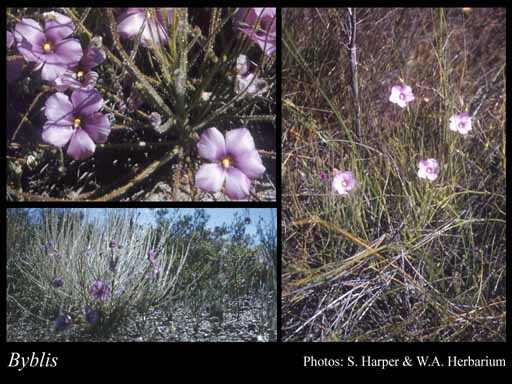- Reference
- Parad.Lond. pt. 95 (1808)
- Name Status
- Current







Scientific Description
Family Byblidaceae.
Habit and leaf form. Herbs. ‘Carnivorous’. Trapping mechanism passive. The traps consisting of the sticky-glandular, non-irritable (flypaper-like) leaves. Annual, or perennial. Leaves alternate; spiral; non-sheathing; simple; epulvinate. Leaf blades entire; linear. Leaves without stipules. Vernation circinnate; circinnate. Leaf anatomy. Hairs present; glandular hairs present. Stem anatomy. Secondary thickening absent.
Reproductive type, pollination. Fertile flowers hermaphrodite. Unisexual flowers absent. Plants hermaphrodite.
Inflorescence and flower features. Flowers solitary; axillary; pedicellate; ebracteate; ebracteolate; regular; 5 merous; cyclic. Free hypanthium absent. Perianth with distinct calyx and corolla; 10; 2 -whorled; isomerous. Calyx 5; 1 -whorled; gamosepalous (basally); imbricate; regular; persistent. Corolla 5; 1 -whorled; gamopetalous (the petals cuneate, shortly connate basally); imbricate, or contorted; regular; pink, or purple, or blue. Corolla members apically fringed, or entire (then apically dentate or serrate). Androecium 5. Androecial members free of the perianth, or adnate; all equal, or markedly unequal (sometimes declinate); free of one another; 1 -whorled. Androecium exclusively of fertile stamens. Stamens 5; isomerous with the perianth; oppositisepalous; all alternating with the corolla members; erect in bud, or inflexed in bud. Anthers connivent; basifixed; non-versatile; dehiscing via short slits (the openings confluent over the anther tip); tetrasporangiate. Gynoecium 2 carpelled. The pistil 2 celled. Gynoecium syncarpous; eu-syncarpous; superior. Ovary plurilocular; 2 locular. Styles 1. Stigmas 1; capitate (or oblong). Placentation axile. Ovules 10–50 per locule (numerous); anatropous.
Fruit and seed features. Fruit non-fleshy; dehiscent; a capsule (2-valved). Capsules loculicidal. Fruit 2 locular. Dispersal unit the seed. Fruit numerous-seeded. Seeds endospermic. Cotyledons 2. Embryo straight.
Geography, cytology, number of species. Native of Australia. Not endemic to Australia. Australian states and territories: Western Australia, Northern Territory, and Queensland. Northern Botanical Province, Eremaean Botanical Province, and South-West Botanical Province.
Taxonomic Literature
- Conran, John G.; Lowrie, Allen; Moyle-Croft, Jessica 2002. A revision of Byblis (Byblidaceae) in south-western Australia.
- Grieve, B. J.; Blackall, W. E. 1998. How to know Western Australian wildflowers : a key to the flora of the extratropical regions of Western Australia. Part II, Dicotyledons (Amaranthaceae to Lythraceae). University of W.A. Press.. Nedlands, W.A..
- Lowrie, Allen; Conran, John G. 1998. A taxonomic revision of the genus Byblis (Byblidaceae) in northern Australia.
- Lowrie, Allen 1998. Carnivorous plants of Australia. Volume 3. University of W.A. Press.. Nedlands, W.A..